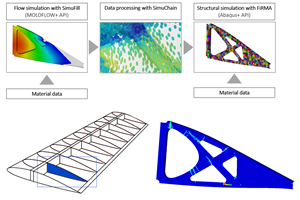Cygnet, Viritech recover H2 tank continuous carbon fibers in Ford FCVGen2.0 project
Partner technologies have demonstrated the viability of recycled continuous fibers and the potential for automotive tanks to be recycled at meaningful rates.
Cygnet Texkimp's Fibre Recovery System unwinds continuous carbon fiber from a demonstrator tank. Source (All Images) | Cygnet Texkimp
Cygnet Texkimp (Northwich, U.K.) and hydrogen powertrain solutions developer (Nuneaton, Warwickshire, U.K.) have partnered to recover high-value, continuous carbon fibers from hydrogen pressure vessels as part of a strategy to improve circularity in the manufacture of filament-wound parts.
The two companies have worked together within the FCVGen2.0 consortium which is led by Ford Motor Co. and partly funded by the Advanced Propulsion Centre UK (APC). The consortium was brought together in 2023 to design, build and trial a small fleet of hydrogen fuel-cell powered Ford E-Transits that maximize value for fleets with high daily energy demands and zero-emissions ambitions. One of its objectives is to develop and evaluate a viable recycling route for end-of-life (EOL) fuel tank components that maintains the properties of, and develops uses for, recycled fiber, in order to accelerate the industrialization of recycling technologies in automotive.
The partnership between Cygnet Texkimp and Viritech harnessed Cygnet Texkimp’s Fibre Recovery System, which addresses one of the project’s key aims: To develop a workable strategy and technical capability to reclaim maximum value from carbon fiber hydrogen tanks at the end of their usable life and reuse them in new applications. The system, which complements Cygnet Texkimp’s filament winding capability, has been developed to recover continuous, high-quality carbon fibers from filament-wound parts and present them in convenient, bobbin-wound formats for reuse in the manufacture of composites.
Viritech tank on a Cygnet Texkimp winding machine.
As part of the project, Viritech is creating composite pressure vessels — using a novel nano-infused, resin-based material system — that achieve optimum efficiency in manufacture and operation, while also being readily recyclable. Cygnet’s technology successfully processed Viritech’s graphene nanomaterial and recovered the tank’s carbon fibers at its Innovation Centre using DEECOM (read about the recycling process). The reclaimed fibers were then mechanically unwound and rewound onto bobbins, ready to be reused in conventional applications.
Unlike many other recycling processes, rCF is typically processed in short lengths and thus is limited in its application. Cygnet’s technology, however, recovers and unwinds continuous fibers to enable their use as an alternative to virgin fibers, i.e., more high-value applications, like filament winding, pultrusion, weaving, unidirectional prepreg and towpreg.
“Our partnership with Viritech demonstrates the potential for hydrogen tanks to be recycled at a meaningful rate,” says Dr. Yan Liu, senior R&D specialist at Cygnet Texkimp, who led the project. “Our Fibre Recovery System has an essential role to play in enabling design for recycling and design for disassembly strategies that inform the manufacture of future hydrogen pressure vessel technology. The system closes the loop between our DEECOM fiber recycling solution and our extensive filament winding capability and provides end-to-end processing and recycling capability for composite fibers.”
The two companies are also working together to further develop the filament winding technology as part of a strategy to develop highly efficient and sustainable manufacturing and recycling solutions for hydrogen pressure vessels. This partnership is based around Cygnet Texkimp’s fully automated, five-axis filament winding cell and Viritech’s graphene nanomaterial system.
Related Content
Improving carbon fiber SMC simulation for aerospace parts
Simutence and Engenuity demonstrate a virtual process chain enabling evaluation of process-induced fiber orientations for improved structural simulation and failure load prediction of a composite wing rib.
Read More“Structured air” TPS safeguards composite structures
Powered by an 85% air/15% pure polyimide aerogel, Blueshift’s novel material system protects structures during transient thermal events from -200°C to beyond 2400°C for rockets, battery boxes and more.
Read MoreBraided thermoplastic composite H2 tanks with co-consolidated molded boss areas to fit EV battery space
BRYSON project demonstrates possible designs, automated manufacturing and low permeability concepts, including EVOH liner and novel PPA matrix.
Read MoreCarbon fiber, bionic design achieve peak performance in race-ready production vehicle
Porsche worked with Action Composites to design and manufacture an innovative carbon fiber safety cage option to lightweight one of its series race vehicles, built in a one-shot compression molding process.
Read MoreRead Next
Toray, Daher and Tarmac Aerosave announce End-of-Life Aircraft Recycling Program
Collaborative initiative aims to reuse secondary structural TPC parts from EOL Airbus A380 aircraft and repurpose them for other aeronautical applications in order to collectively advance TPC recycling technologies.
Read MoreThe AMRC announces U.K. open-access TPC tape development
Dedicated research platform, available to businesses and researchers at the AMRC’s Factory of the Future facility, features Cygnet Texkimp’s hybrid line and tape slitter on a pilot scale.
Read MoreNext-gen fan blades: Hybrid twin RTM, printed sensors, laser shock disassembly
MORPHO project demonstrates blade with 20% faster RTM cure cycle, uses AI-based monitoring for improved maintenance/life cycle management and proves laser shock disassembly for recycling.
Read More









